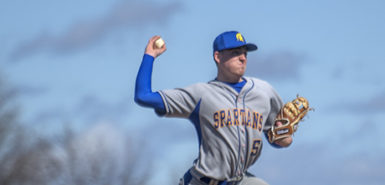
Spring training has already begun for Major League Baseball teams and many high schools.
And nowadays, school baseball season is followed by summer leagues and travel teams for all ages that can stretch into fall and winter.
Although baseball can seem like a full-year commitment, experts say well-managed spring training and a few baseball-free months in the off-season are essential to keeping young athletes’ arms healthy.
“We see so many overuse symptoms and injuries in baseball,” said Matthew Axtman, DO, who specializes in sports medicine for Spectrum Health Medical Group.
“There’s been such a large increase in Tommy John surgery,” he said. “You can see that has exponentially grown through the years and become more common, because parents and coaches keep pushing their kids and players to strive to be the best they can be, and they’re actually doing something detrimental to their arms.”
Well-armed practice
Tommy John surgery, also known as reconstruction of the ulnar collateral ligament, is a procedure in which a ligament from the elbow is replaced with a tendon from elsewhere in the body.
It has become one of the most common procedures in baseball, as youth sports have become more specialized and kids play baseball year-round. About 25 percent of active MLB pitchers have had the surgery, according to the New York Times.
A recent study that examined 235 major league pitchers who had the operation from 1999 to 2014 also found that more than 13 percent of those pitchers have had the surgery a second time.
During spring training, as well as during the season and the off-season, it’s key to exercise all of the muscles associated with throwing, Dr. Axtman said—the elbow, the shoulder, shoulder blades and the lower body.
This takes stress off the elbow and helps keep it healthy.
“It’s everything from the neck to the wrist—it’s all one chain,” Dr. Axtman said. “You’ve got biceps, triceps, forearm muscles: All of it is important. You want to isolate the muscles smartly and target that entire arm.”
Working with a knowledgeable pitching coach to develop proper mechanics can also avoid “terrible outcomes,” he said.
Throwing a baseball at 80-plus miles per hour requires an astonishing amount of force, so if body parts are not in sync and one muscle group is doing too much work, it can do significant damage to the body very quickly.
“If you have poor mechanics, that can shorten your season, shorten the number of innings you can throw and set you up for injury and surgical procedures in the future,” Dr. Axtman said. “If your mechanics are abnormal, that throws everything off.”
Well-rounded athlete
There are two other key factors, experts say, to staying healthy both short-term and long-term: Pitch counts and cross-training.
Dr. James Andrews, the most famous sports medicine doctor in the country—he sees hundreds of high-profile athletes each year—recommends youth pitchers never throw more than 100 pitches in a day, citing the American Sports Medicine Institute’s guidelines, which he helped write.
Furthermore, anything over 75 pitches a day requires four days of rest. Any day with more than 45 pitches requires at least two days of rest.
The guidelines also recommend at least two months per year when an athlete is not engaged in baseball activities. And pitchers, coaches and parents should recognize when a player’s arm is fatigued and mandate rest and recovery time.
Signs of a fatigued arm include lingering soreness, decreased velocity, or a change in mechanics while on the mound.
Lastly, during those months off from baseball, players should cross train by playing other sports, Dr. Axtman said.
“Some of the best athletes are multi-sport athletes,” Dr. Axtman said. “Football, baseball, soccer and what have you, those all target different groups of muscles.
“It helps maintain the health and strength of the entire body, which sets you up for a better, healthier baseball season,” he said.
Hall-of-Fame baseball player Cal Ripken Jr. played multiple sports and enjoyed a famously long career.
“(Ripken) was known as the Iron Man for being able to stay healthy and play everyday,” Dr. Axtman said. “That kind of sheds light on what you should do. You want to make sure you’re a well-rounded individual, a well-rounded athlete.”
 /a>
/a>
 /a>
/a>
 /a>
/a>